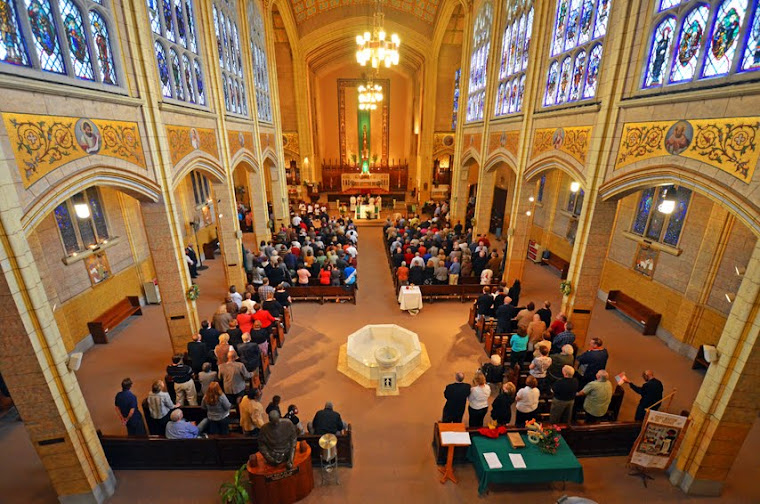Joy and sadness to christen parish
It is a new church, and it isn't. It is a beginning, but also an end. It is a time of joy, and a time of sorrow.
On Feb. 9, Cardinal Joseph Bernardin will go to the Austin neighborhood on Chicago's Far West Side for the formal dedication of St. Martin de Porres Catholic Church, 5112 W. Washington Blvd.
St. Martin was a 17th Century mulatto physician whose work as a Dominican lay brother among the sick and poor of Peru made him that country's patron saint of social justice.
The new parish, named for him, is made up of some 500 families, nearly all of them African-Americans, who come from throughout the city and even the suburbs to worship together.
The parish was organized in 1988, but it wasn't until last Nov. 3, St. Martin's feast day, that the congregation was able to move into its permanent worship site.
"It's beautiful," says Sandra Backstrom, a Chicago public school teacher. "For me, it's a dream come true."
Much of Backstrom's happiness comes from the fact that St. Martin really isn't a new church. Instead, it's a new parish in an old church building, the same building where she worshiped for more than 15 years as a member of the St. Thomas Aquinas parish.
The St. Thomas Aquinas church building, which had served West Side Catholics for 64 years, was closed three years ago and had been in danger of being torn down. To see it now, reopened and renovated at a cost of nearly $700,000, gives Backstrom a keen delight.
But there are many for whom the joy of next month's formal dedication will be mixed with sadness and regret.
The new St. Martin parish is the result of financial difficulties that led Bernardin to urge the consolidation of three West Side parishes: St. Thomas Aquinas, St. Mel-Holy Ghost and Resurrection.
Following a long meeting process, congregation members decided that they wanted to put up a new church building for their new parish, rather than renovate any of the worship sites of the three old parishes.
But, by that time, the fall of 1990, the archdiocese was in even deeper financial trouble, and Bernardin said a new building was out of the question. Instead, the archdiocese would help pay for the renovation of the St. Thomas Aquinas structure.
"I was disappointed, of course. I shed tears, of course," says Alberta Bowles, a hospital social worker who had wanted a new church building.
And, if not a new building, Bowles would have preferred to have the consolidated congregation meet in the chapel of the old Resurrection parish in the bottom floor of the parish school.
"The Res chapel was viewed as a basement," she says. "But, for those of us who had been worshiping there for years and years, that was church."
Yet, even for the old St. Thomas Aquinas parishioners, there were sorrows that came from the renovation.
As part of the modest redecorating of the building, a bust of St. Martin was put near the front door and a sculpture of the saint was placed in a side alcove.
At the same time, a statue of St. Thomas, one of the most influential theologians in Catholic history, was removed, and the image of St. Thomas that had loomed over the altar in a 50-foot-tall tapestry was painted over.
"I really miss St. Thomas," says Sandra Hilal. "I often sit there and pray that that paint just peels off."
In its first three years, the consolidated parish had celebrated Sunday mass at the St. Mel-Holy Ghost church building, 4301 W. Washington Blvd. It was during that time that Hilal, a resident of the north lakefront neighborhood of Uptown, stopped coming on a regular basis.
Her return coincided with the move to the old St. Thomas building, but she says, "It wasn't the reopening of the church. I'm back because I missed my church family."
She explains: "The people of St. Thomas -- and, I suspect, of St. Mel and Res -- if you're sick, they'll come see you. If your family has problems, they're right there for you. In this parish, if you cry, someone cries with you. And if it's a joyful occasion, they're joyful with you."
Those comments were echoed by others from other parishes. "Wherever my church family is at, that's where I want to be," says Patricia Buford, the president of the choir.
Buford is from Resurrection, as is Avusa Farmer, who despite the bumpy journey that the consolidated congregation has had, says:
"We're one now. You can see people from all three parishes coming together and working together, more so than before. This church is beautiful. Now, hopefully, we're home."
Chicago Tribune, January 22, 1992, page 1.
Author, Patrick T. Reardon, (Class of 1963)

No comments:
Post a Comment